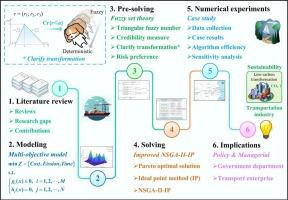碳交易价格的不确定性如何影响多式联运网络?来自枢纽海港的洞察
IF 6.8
1区 工程技术
Q1 ECONOMICS
Transportation Research Part A-Policy and Practice
Pub Date : 2025-08-05
DOI:10.1016/j.tra.2025.104621
引用次数: 0
摘要
本研究通过关注枢纽海港多式联运货运网络(IFTN)的设计并考虑碳交易价格的不确定性,解决了当前货运系统的结构性无效问题。基于三角模糊数建立了碳交易价格的模糊可信度函数,并利用与企业风险偏好水平相关联的不同值来厘清模糊碳交易价格。构建了考虑运输成本、碳交易成本和运输时间的多目标0-1规划模型。设计了一种基于理想点法的改进NSGA-II来求解该模型。最后,以中国某枢纽港为例,通过数值实验验证了该模型的有效性和求解效率。在广泛的敏感性分析基础上提出管理影响和建议。结果突出显示了以下内容。(1)在碳交易政策的影响下,运输企业采用铁路直运或铁水联运。(ii)碳交易成本的客观价值与企业相对于碳交易价格的风险偏好水平成反比。这说明企业在不同风险态度下的减排决策行为是由成本或效益驱动的。(三)从建模角度看,碳配额不太可能有效地影响运输计划,但强调其作为减少排放政策工具的有效性是有用的。这些发现可以应用于加速运输和物流业的可持续转型和脱碳工作。本文章由计算机程序翻译,如有差异,请以英文原文为准。

How does carbon trading price uncertainty affect intermodal transportation network? Insights from a hub seaport
This study addresses the current structural ineffectiveness of freight transportation systems, by focusing on the design of a hub seaport intermodal freight transportation network (IFTN) and considering uncertainties in the carbon trading price. The fuzzy credibility function of the carbon trading price is established based on a triangular fuzzy number, and the fuzzy carbon trading price is clarified using different values associated with an enterprise’s risk preference level. A multi-objective 0–1 programming model is constructed, considering transportation cost, carbon trading cost, and transportation time. An improved NSGA-II based on the ideal point method is designed to solve the model. The effectiveness and efficiency of the modeling and solving methods are demonstrated through numerical experiments for the real-world case of a Chinese hub seaport. Managerial implications and recommendations are presented based on extensive sensitivity analyses. The results highlight the following. (i) Under the influence of carbon trading policy, transport enterprises adopt direct rail or rail-water intermodal transportation. (ii) The objective value of carbon trading cost is inversely proportional to an enterprise’s risk preference level with respect to the carbon trading price. This indicates that an enterprise’s decision-making behavior related to emissions reduction under different risk attitudes is prompted by costs or benefits. (iii) Carbon quotas are unlikely to effectively affect transportation schemes from a modeling perspective, but it is useful to emphasize their effectiveness as an emissions reduction policy instrument. These findings can be applied to accelerate the sustainable transformation and decarbonization efforts of the transport and logistics industry.
求助全文
通过发布文献求助,成功后即可免费获取论文全文。
去求助
来源期刊
CiteScore
13.20
自引率
7.80%
发文量
257
审稿时长
9.8 months
期刊介绍:
Transportation Research: Part A contains papers of general interest in all passenger and freight transportation modes: policy analysis, formulation and evaluation; planning; interaction with the political, socioeconomic and physical environment; design, management and evaluation of transportation systems. Topics are approached from any discipline or perspective: economics, engineering, sociology, psychology, etc. Case studies, survey and expository papers are included, as are articles which contribute to unification of the field, or to an understanding of the comparative aspects of different systems. Papers which assess the scope for technological innovation within a social or political framework are also published. The journal is international, and places equal emphasis on the problems of industrialized and non-industrialized regions.
Part A''s aims and scope are complementary to Transportation Research Part B: Methodological, Part C: Emerging Technologies and Part D: Transport and Environment. Part E: Logistics and Transportation Review. Part F: Traffic Psychology and Behaviour. The complete set forms the most cohesive and comprehensive reference of current research in transportation science.

 求助内容:
求助内容: 应助结果提醒方式:
应助结果提醒方式:


